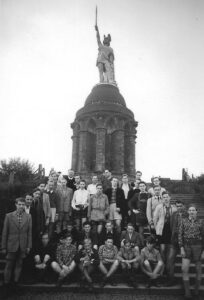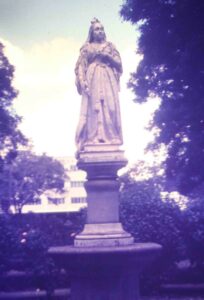Franz Kröger
Roman Provinces and British Colonies
Living Between Two Cultures

1953: A schoolclass in front of the monument
Please, allow me to start my article with a chapter from Teutonic history. I will come back to Africa soon.
More than 2000 years ago, i.e. in the time when Christ preached and performed miracles in Palestine, the European areas north of the Roman Empire were populated with peoples regarded as little civilized and organised into tribes. After Julius Caesar had conquered Gaul (or Gallia in Latin), an area settled by the Celtic Gauls, it was the cultural and ethnic region called “Germania” that remained independent and, as such, a desirable object of Roman desire for more conquered land. Thus Emperor Augustus (63 BC – 14 AD) planned to make it another Roman province.
Who were these Germanic peoples? Much of our knowledge about them has been handed down to us by way of the Roman historian Cornelius Tacitus (ca. 56-120 AD) and his book De origine et situ Germanorum henceforth referred to as Germania. For the Romans, these northern peoples were barbaric, uncivilised, pagan and warlike. Nevertheless, Tacitus also saw some positive traits in them: He admired their strict moral life and respect for marriage, especially when he compared them with the “immoral” Romans of his time (Tacitus chapter 19). He admired their bravery, their hospitality (chapter 21), their high esteem of women (chapter 8) and even feared that one day in the future they might become dangerous to the Roman Empire.
After the conquest of Gaul, Emperor Augustus thought it might be easy to defeat the wild but brave Germanic hordes who were good lone warriors but seemed to be easy game for the disciplined, well-equipped and well-trained Roman legionaries.
In 9 AD a group of Germanic warriors under the command of one Arminius succeeded in luring three Roman legions under the command of Publius Quinctilius Varus into a wooded and swampy ambush, where they were destroyed in a single battle. After these losses, the Romans gave up their attempt to conquer all of Germania and limited themselves to the areas to the left of the Rhine and to the south of the Danube. The open and unprotected space between these two rivers was enclosed by a protective wall (Limes).
Let us now take a leap into the 19th century, a time when a new nationalism was emerging in the peoples of Europe. Looking for heroes in the past, Arminius (or Hermann as he was called in a doubtful translation) became an ideal for many German generations. In 1875 the architect Ernst von Bandel created a huge (53-meter-tall) statue, which is comparable to the American Statue of Liberty (93 meters tall), at the place (near Detmold) which was (falsely) assumed to be the battle site. It was to play a major role in the Arminius cult of the 19th and 20th centuries. For many German pupils a visit to this monument at least once before they finished school was almost obligatory. The author also experienced his first visit there with his secondary school class in 1953 (see photo).
The veneration of Arminius found its counterpart in the contempt of Segestes, another Germanic prince who was considered the typical traitor. He wished for the subjugation of the entire Germanic territory under the Romans, warned Varus before the great battle (in vain!) and handed over Thusnelda, his daughter and wife of Arminius, to Roman slavers.
Only in recent times has this simplistic view of history been critically examined. Above all, the question remains: Are the present Germans cultural descendants of the Romans or the Germanic people?
As a pupil at a German Secondary School in the 1950s, I learnt that the development of the culture of the new Occident in the Middle Ages was strongly influenced by the following elements:
1. Teutonic culture. (This may also include the countries speaking Romance languages such as France, Spain and Italy where Franks, Goths and Longobards replaced Roman rule).
2. Christianity, which had come to Europe with the Romans.
3. Ancient Roman culture, which had found its way into the Occident via the Roman occupying forces.
If this analysis is correct, the question of how much each of these different factors has affected German culture remains open.
Apart from the language of the Germanic-speaking peoples and states (England, Scandinavia, the German and Dutch language area, etc.), the proportion of “Germanness” seems to be the lowest in these areas. The Christian-Roman influence, expressed by the Holy Roman Empire (until 1806), the great number of old cathedrals and monasteries, the retention of Latin as the language of the church and scholars (endnote 1) – these aspects of Roman life had a greater impact on the area.
In this light, the high esteem in which the ancient Germanic tribes were held and the veneration of Arminius both seem to be inappropriate (endnote 2). One of my Latin teachers (Latin was my first foreign language and a compulsory subject for 9 years!) expressed it like this: “As cultural descendants of the Romans, we should have set a monument to Segestes, not to Arminius”.
The division of the old Germania into a Roman-occupied and unoccupied territory left its traces for many centuries. All large and important cities of the medieval Occident developed in the formerly occupied territory:
Trier (Treves) had, for a time, been one of the largest cities of the Roman Empire and the residence of one Roman Emperor.
Aachen was the preferred residence of Charlemagne and, from 936-1531, the place where German kings were crowned.
Cologne (or Köln in German) was the biggest German town during the Middle Ages.
In Frankfurt the German king was elected (starting in 1356) and crowned (1562-1792).
Of the seven electors, who, after 1356 elected the German king, four were princes or archbishops from the area once occupied by the Romans.

Fergusons’ grave in Wa (Northern Ghana)

Queen Victoria’s monument in Nairobi (1970)
The cultural development of the areas not under Roman occupation was hindered until early modern times. With these results we can conclude our presentation and analysis of this chapter of German history.
Which analogies to European development, as presented above, exist in the cultural and social development of Africa in modern times when British and other European powers were able to conquer large parts of Africa? There are some obvious historical analogies:
1) Mighty military powers, strong by virtue of their material superiority, especially with regard to their possession of more effective weapons, invade and oppress other countries without legal and moral justification and make them provinces, respectively colonies.
2) The victorious powers resort to drastic means in order to dominate and economically exploit the subjugated territories, for example through forced labour, the recruitment of natives into the Roman/colonial army and the levying of tributes/taxes.
3) The colonial powers more or less in agreement with the subjugated peoples (often at the request of them) demand to accept parts of the Roman or British culture. In Ghana, for example, this has included attending schools, accepting a Christian denomination and learning the English language. In time, the colonized realize that this adoption and these newly-acquired skills might be of financial or social benefit to them.
After gaining independence (in 1957 in the case of Ghana), the educated youth were faced with the difficult problem concerning their attitude towards the traditional native and the new European culture. Compared to the situation in Germania at the time of Arminius, they had not gained their independence through an uprising or a bloody battle, but through tough negotiations and passive resistance. Their hatred of their British oppressors was also constrained as shown, for example, by their voluntarily remaining in the Commonwealth.
Theoretically, there were two possible ways to shape their now independent state and society:
1. They could try to eliminate the period of colonial rule as a historical epoch in their memory, i.e. they could abolish schools, return to traditional religion and abolish English in its role as the official state language. This possibility, in all its radicality, has, as far as I know, never and nowhere been seriously considered.
2. It was much easier to maintain the order created by the British and put only the leading positions into Ghanaian hands. The English language, the political organization, with its highly-centralised government, and the continued existence of Christian communities and churches (with their missionary schools) seemed to be a guarantee that the new state would not disintegrate again into independent kingdoms and tribal organisations.
Decades after independence, a strong and educated elite had grown up in Ghana. With English as their colloquial language, their affiliation to Christian churches and their more or less European manners, clothing, food preferences, etc., these members of the elite class generally felt very comfortable in their positions.
The official diplomatic relations with the country of their former colonial masters was never very strained after 1957, and in the individual life of an educated Ghanaian (and Bulsa), a stay of several years in Europe or America has always been desirable.
Let us return to the question asked in the first part of this article, though reformulated with regard to Ghana:
To whom should Ghanaians erect a monument, i.e. whom should they consider a national hero? To a native who rose up against the British rule? Or to the British or one of their African collaborators who turned the region into a British colony? For the northern part of modern Ghana, it was Ferguson, the son of a Fante woman, who used all of his power to make the north (including the Bulsa area) part of the British Empire because he was firmly convinced that this was in the best interest of the African population. In the conflicts between the British and local powers, Ferguson was captured and executed by Samori’s soldiers. As far as I know, the educated Ghanaians regard him neither as a hero nor as a traitor. Nevertheless, his grave in Wa with a tombstone and an inscription is attended to and respected.
Other former European colonies, too, display an ambiguous attitude towards their former colonial masters. The British monarch under whom the British Empire grew and expanded the most was Queen Victoria (1837-1901). How astonished I was , when I saw a large monument to her in the centre of Nairobi, Kenya. The Frenchman Binger (1856-1936) played a large part in the conquest of several colonies in West Africa (for example, the Upper Volta, which is known today as Burkina Faso). When I visited Ouagadougou for the first time, I was astonished that the magnificent main street leading to the President’s Palace was called “Avenue Binger” after the French colonialist and governor of Ivory Coast, although, the street has since been renamed.
Our final question will be: Should we lament the position of the many Africans straddling an African and European culture? Not at all! For this is precisely where a great opportunity for the future lies. Old African ideas and cultural expressions should be fertilised by European impulses. Every African today has the opportunity to choose which cultural elements he wants to adopt and which he wants to vehemently reject. If the right choice is made here, it can lead to a fruitful symbiosis and thus to a new flowering of African cultures and states.
Excursus: French Imperialism
Beginning in the 19th century, the French government had an attitude towards the treatment of subjugated peoples that was different from that of the British. The French were obsessed with the idea of transferring their own culture, which was regarded as superior, to as many peoples on earth as possible. In contrast, the British sense of mission was influenced by their belief in themselves as “chosen people”. Accordingly, when a strong, educated upper class in the French colonies began demanding greater freedom and independence, the attitude of the French was different from that of the British. The British, in such a case, sought to unite such colonies into a federation of free states (i.e. the Commonwealth) with the British king or queen remaining head of the federation. The French, on the other hand, wanted to make the colonial peoples culturally French and to give them political rights as French citizens, for example, by allowing them to have representatives in the French parliament.
An example of successful cultural assimilation is the politician, cultural theorist and poet Léopold S. Sénghor (1906-2001). After his education in French West Africa (now Senegal), he began studying in France in 1928 and accepted French citizenship in 1932. From 1939 to 1942, he fought as a private in the French army. Sénghor taught as a professor in Paris and Tours and was elected as a member of the Académie Française and as an MP in the French Parliament.
After Senegal’s independence, he was the new state’s first president from 1960 to 1980. After resigning this position, he and his French wife left Senegal in order to live the rest of their lives in France.
References
Tacitus, P. Cornelius: Germania [Latin edition], ed. Hartmut Froesch, Reclams Universalbibliothek, Fremdsprachentexte, Stuttgart 2012.
Wikipedia (English, retrieved July 2020): “Arminius”, “Hermannsdenkmal”, “Leopold Sédar Senghor” , “Segestes”, “Tacitus”, “G.E. Ferguson”.
Endnotes
1. Until the 20th century, PhD theses had to be written exclusively in Latin.
2. I cannot remember any major celebrations of the 1000th anniversary of the Battle of Varus in 2009.
- Editorial
- Various Authors and Sources: Events
- Franz Kröger: Who on Earth Is Interested in the Bulsa? The Bulsa Internet Websites 2018-2020
- The 2019 Feok Festival – a Trilogy
- THE TITLE AND POSITION OF THE SANDEMNAB – A DISCUSSION
- Francis A. Azognab: Should Christians Attend Traditional Funeral Celebrations?
- Stephen Azundem: Exploring the Jewish Concept of Ritual Cleansing from a Bulsa Perspective
- Joseph Aduedem: The Art of Shepherding – The Origins of Conflict with Farmers in the Cultural Context of the Bulsa
- Joseph Aduedem: Kuub Juka or Ngomsika, the Second Funeral Celebration
- Franz Kröger: The Koma and Bulsa (Builsa) of Northern Ghana
- Franz Kröger: Can a Visual Perception be expressed by Sounds? The Buli Ideophones
- Franz Kröger: Good and Evil in Matter and Living Beings
- Franz Kröger: Roman Provinces and British Colonies — Living Between Two Cultures
- Franz Kröger: Sylvester Ateteng Azantilow 1950-2020 (obituary)
- MAIN FEATURE: CREATIVE BULSA: ARTISTS, POETS AND WRITERS
- Patrick Seidu aka Saala-Biik Soakatoa: My Life and Career
- Franz Kröger: Daniel Bukari, an Amateur Artist
- Eric A. Anadem, a Photographer and Artist
- Ghanatta Ayaric: Hard Road to Travel
- John Agandin: A Trotro Ride from New Town to Accra
- John Agandin: The Kayayei’s Tale
- John Agandin: Korona Vairosiwa Tugurika
- Ghanatta Ayaric: In the Meantime!
- Anbegwon Atuire: Rhythm of the War Dance
- Robert Asekabta: Continue Revolution
- Poems in BULUK 1-13